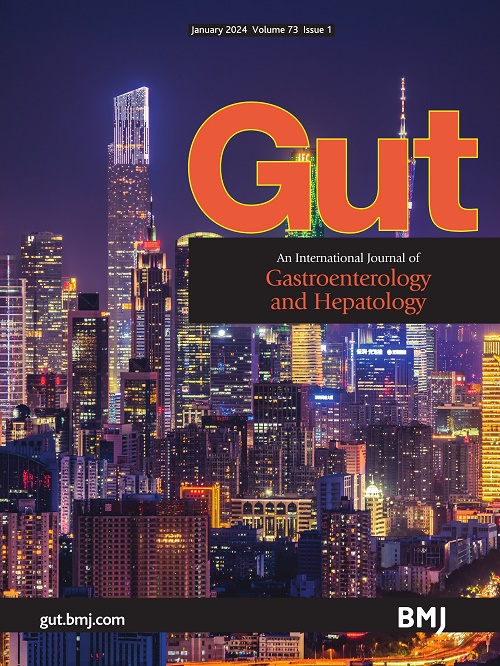Mitochondrial dysfunction drives basal cell hyperplasia in eosinophilic oesophagitis.
IF 25.8
1区 医学
Q1 GASTROENTEROLOGY & HEPATOLOGY
引用次数: 0
Abstract
BACKGROUND Eosinophilic oesophagitis (EoE) is a food allergen-induced inflammatory disorder characterised by interleukin (IL)-13-mediated oesophageal inflammation and epithelial basal cell hyperplasia (BCH). The role of mitochondria in EoE pathogenesis remains elusive. DESIGN Prompted by single cell transcriptomics data, we interrogated the role of mitochondria in EoE pathobiology using patient biopsies, EoE-mouse models and oesophageal epithelial cells grown in monolayer and three-dimensional (3D) organoid cultures treated with EoE-relevant cytokines. 3D organoids and EoE-bearing mice were treated with omeprazole-a proton-pump inhibitor used as first-line EoE therapy. We performed CRISPR (Clustered Regularly Interspaced Short Palindromic Repeats) interference in mouse organoids to identify the key mitochondrial regulatory genes whose depletion may lead to BCH. We analysed mitochondrial membrane potential, mass and superoxide production by flow cytometry, cellular oxygen consumption by respirometry, mitochondrial structures and perturbation of cellular energy homeostasis by immunoblotting. RESULTS : Mitochondrial dysfunction appeared to be a hallmark of EoE-related BCH where mitochondrial structural damage was associated with impaired oxidative respiratory capacity, elevation of mitochondrial superoxide and decreased adenosine triphosphate (ATP) production, as corroborated by activation of the adenosine monophosphate (AMP) -activated protein kinase and suppression of mammalian target-of-rapamycin signalling. Depletion of PGC1A, the master regulator of mitochondria biogenesis, recapitulated EoE-related BCH, suggesting that mitochondrial dysfunction drives BCH. Further, omeprazole alleviated mitochondrial damage and dysfunction in EoE-related BCH modelled in mice and patient-derived organoids. CONCLUSION: Mitochondrial dysfunction is tightly linked to perturbation of redox homeostasis in EoE-related BCH, which is promoted by IL-13 and reversible with omeprazole treatment.嗜酸性食管炎患者线粒体功能障碍驱动基底细胞增生。
嗜酸性食管炎(EoE)是一种食物过敏原诱导的炎症性疾病,以白细胞介素(IL)-13介导的食管炎症和上皮基底细胞增生(BCH)为特征。线粒体在EoE发病机制中的作用尚不明确。在单细胞转录组学数据的提示下,我们通过患者活检、EoE小鼠模型和在单层和三维(3D)类器官培养物中培养的食管上皮细胞,用EoE相关细胞因子处理,研究了线粒体在EoE病理生物学中的作用。3D类器官和携带EoE的小鼠用奥美拉唑治疗,奥美拉唑是一种质子泵抑制剂,用于一线EoE治疗。我们对小鼠类器官进行了CRISPR (Clustered Regularly Interspaced Short Palindromic Repeats)干扰,以确定缺失可能导致BCH的关键线粒体调控基因。我们通过流式细胞仪分析了线粒体膜电位、质量和超氧化物的产生,通过呼吸仪分析了细胞耗氧量,通过免疫印迹分析了线粒体结构和细胞能量稳态的扰动。结果:线粒体功能障碍似乎是eoe相关BCH的一个标志,线粒体结构损伤与氧化呼吸能力受损、线粒体超氧化物水平升高和三磷酸腺苷(ATP)产生减少有关,这一点得到了单磷酸腺苷(AMP)激活的蛋白激酶和哺乳动物雷帕霉素靶点信号传导抑制的证实。线粒体生物发生的主要调节因子PGC1A的缺失,再现了ee相关的BCH,表明线粒体功能障碍驱动了BCH。此外,奥美拉唑减轻了小鼠和患者源性类器官模型中ee相关BCH的线粒体损伤和功能障碍。结论:线粒体功能障碍与eee相关BCH氧化还原稳态的扰动密切相关,IL-13可促进这一过程,并可通过奥美拉唑治疗逆转。
本文章由计算机程序翻译,如有差异,请以英文原文为准。
求助全文
约1分钟内获得全文
求助全文
来源期刊

Gut
医学-胃肠肝病学
CiteScore
45.70
自引率
2.40%
发文量
284
审稿时长
1.5 months
期刊介绍:
Gut is a renowned international journal specializing in gastroenterology and hepatology, known for its high-quality clinical research covering the alimentary tract, liver, biliary tree, and pancreas. It offers authoritative and current coverage across all aspects of gastroenterology and hepatology, featuring articles on emerging disease mechanisms and innovative diagnostic and therapeutic approaches authored by leading experts.
As the flagship journal of BMJ's gastroenterology portfolio, Gut is accompanied by two companion journals: Frontline Gastroenterology, focusing on education and practice-oriented papers, and BMJ Open Gastroenterology for open access original research.
 求助内容:
求助内容: 应助结果提醒方式:
应助结果提醒方式:


